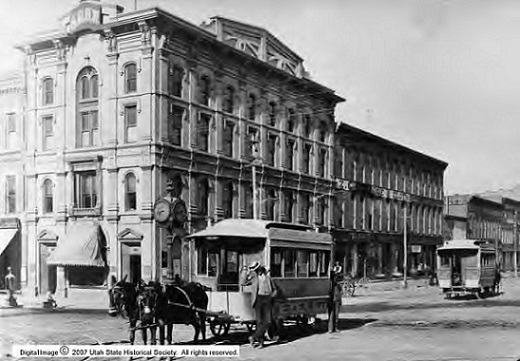Dublin Core
Title
Description
The Eagle Emporium remains the Salt Lake City’s “only commercial structure built prior to the completion of the transcontinental railroad.”
In 1864, English immigrant William Jennings opened a mercantile business in the Eagle Emporium. The building, which still stands at 102 South Main Street in Salt Lake, is, according to the Utah Heritage Foundation, the city’s “only remaining commercial structure built prior to the completion of the transcontinental railroad.”
Jennings, who arrived in Salt Lake in 1852, began his business career as a butcher and tanner, before branching out into dry goods with the construction of the Emporium. The structure began as a rather modest one-story building, but it quickly became a center of Mormon commercial might. In 1868, when Brigham Young proposed the idea of the Zion’s Commercial Mercantile Institution, or ZCMI, as a counterbalance to the growing influence of non-Mormon merchants in Salt Lake, Jennings offered up his Eagle Emporium as the cooperative’s first home.
Over time the Emporium was remodeled, with two stories being added in the 1880s. At the same time, William Jennings was climbing Utah’s political ladder, first winning a seat in the territorial legislature and then being elected mayor of Salt Lake City in 1882. He was later forced out of the mayor’s office due to enforcement of the Edmunds Act which prohibited polygamists from holding public office.
In the 1890s, Utah National (later Zions) Bank moved into the old Emporium building, later remodeling the structure yet again, this time covering its original red sandstone face with a terra-cotta veneer. Today, the ornate character of the building’s exterior bears little resemblance to the more modest store Jennings built in the 1860s, yet it reminds us how historic buildings over time almost develop lives of their own.
Creator
Source
Image: Salt Lake City First South and State. ca. 1872-1880. Street-level view of First South Street, southwest corner, Salt Lake City, Utah. Image shows "Old Clock Corner" and mule-powered streetcars in front of Eagle Emporium, later to become Utah State Bank, and then the first home of Z.C.M.I. Courtesy of Utah State Historical Society.
_______________
See John S. McCormick, Salt Lake City: The Gathering Place (Woodland Hills, California: Windsor Publications, 1980), 44; John S. McCormick, The Historic Buildings of Downtown Salt Lake City (Salt Lake City: Utah State Historical Society, 1982), 62l; Thomas G. Alexander and James B. Allen, Mormons and Gentiles: A History of Salt Lake City (Boulder, Colorado: Pruett Publishing, 1984), 68 and 102; and Thomas G. Alexander, Grace and Grandeur: A History of Salt Lake City (Carlsbad, California: Heritage Media, 2001). Also see the Utah Heritage Foundation’s Main Street Tour Guide

